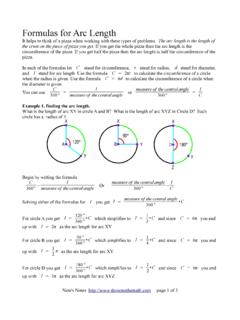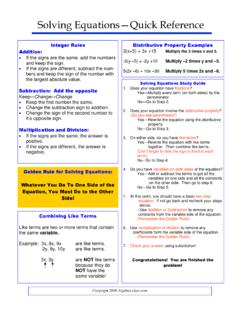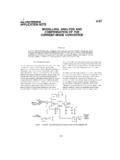Transcription of Slope Formula - showmethemath.com
1 Slope Formula The symbol for Slope is m. Slope is the rate of change of the dependent variable y with respect to the independent variable x . To find the Slope of a line pick two points from the line: point 1 (x1,y1) and point 2 (x2,y2). Put these points into the Formula for Slope . It does not matter which points you pick for point 1 and point 2 nor does it matter which Formula you use. What does matter is that you subtract the point 1 values from the point 2 values or that you subtract the point 2 values from the point 1 values as shown below in the Formula . change in y rise y2 - y1 y1 - y2. m= = = =. change in x run x2 - x1 x1 - x2. Example, find the Slope of the line with points (2,3) and (-7,8). Use both formulas to verify you get the same Slope . y2 - y1 8-3 5 5. m= = = = - x2 - x1 -7 - 2 -9 9. y1 - y2 3-8 -5 5. m= = = = - x1 - x2 2 - -7 9 9. Slope -Intercept form of an Equation y = mx + b Y-intercept, the point where the line crosses, intersects, intercepts, comes in contact with, meets, shares a common point, engages with the y-axis.
2 The number by itself including the sign in front of it is b. It is an actual point with an x-coordinate and a y- coordinate. This Formula only uses the value of the y-coordinate which is what b stands for. The y-intercept is the first point you plot when you start the graph of the equation. The Slope is m. This is the number that x is multiplied by. If it is not a fraction put a 1 under it to make it a fraction. The Slope tells you how to get to the next point. The number on top tells you how many spaces to move vertically and the sign tells which direction, up if positive down if negative. The bottom number tells you how many spaces to move horizontally and the sign tells the direction, left if negative right if positive. Graphing Equations Put equations in Slope -intercept form by solving for y before graphing them. Make sure that y is on the left side of the equation (for equations it is not actually required to have y on the left side but it is standard practice.)
3 When graphing inequalities it is required). Once that is done the equation tells you everything you need to make the graph. All the graphs start at the y- intercept b. The Slope tells you how to get to the next point. The number on top tells you how many spaces to move vertically and the sign tells which direction, up if positive down if negative. The bottom number tells you how many spaces to move horizontally and the sign tells the direction, left if negative right if positive. 14 y 14 y 13 13. 12 12. 11 11. 10 10. 9 9. 8 8. 7 7. 6 6. 5 5. 4 4. 3 3. 2 2. 1 1. x x -14 -13 -12 -11 -10 -9 -8 -7 -6 -5 -4 -3 -2 -1 1 2 3 4 5 6 7 8 9 10 11 12 13 14 15 -14 -13 -12 -11 -10 -9 -8 -7 -6 -5 -4 -3 -2 -1 1 2 3 4 5 6 7 8 9 10 11 12 13 14 15. -1 -1. -2 -2. -3 -3. -4. 1 2. -4. -5 -5. -6 -6. -7 -7. -8 -8. -9 -9. -10 -10. -11 -11. -12 -12. -13 -13. -14 -14. m = -2 m=2. b=4 b = -4. Write the equation in Slope -intercept form Write the equation in Slope -intercept form and graph it.
4 And graph it. 14 y 14 y 13 13. 12 12. 11 11. 10 10. 9 9. 8 8. 7 7. 6 6. 5 5. 4 4. 3 3. 2 2. 1 1. x x -14 -13 -12 -11 -10 -9 -8 -7 -6 -5 -4 -3 -2 -1 1 2 3 4 5 6 7 8 9 10 11 12 13 14 15 -14 -13 -12 -11 -10 -9 -8 -7 -6 -5 -4 -3 -2 -1 1 2 3 4 5 6 7 8 9 10 11 12 13 14 15. -1 -1. -2 -2. -3 -3. 3 4. -4 -4. -5 -5. -6 -6. -7 -7. -8 -8. -9 -9. -10 -10. -11 -11. -12 -12. -13 -13. -14 -14. m = -2 m=2. b = -4 b=4. Write the equation in Slope -intercept form Write the equation in Slope -intercept form and graph and graph it. Using the Slope -Intercept form of an Equation to Find the Slope and Y-Intercept y = mx + b Only when an equation is in Slope -intercept form will you be able to just look at it and know what the Slope m is and the y-intercept b is. The Slope m is the number x is multiplied by and the y-intercept b is the number by itself (including the sign in front of it). For example in the equation y = 3x -9 the Slope m is 3 and the y-intercept b is -9.
5 When an equation is not solved for y it is not in Slope -intercept form so this does not work. You need to put it in Slope -intercept form by solving for y first before you can apply this trick. For example y + 6x = 12 is not in Slope -intercept form . The Slope is not 6. Solving for y you get y = -6x +12. Now it is in Slope -intercept form so the Slope m is -6 and the y-intercept b is 12. 14 y 14 y 13 13. 12 12. 11 11. 10 10. 9 9. 8 8. 7 7. 6 6. 5 5. 4 4. 3 3. 2 2. 1 1. x x -14 -13 -12 -11 -10 -9 -8 -7 -6 -5 -4 -3 -2 -1 1 2 3 4 5 6 7 8 9 10 11 12 13 14 15 -14 -13 -12 -11 -10 -9 -8 -7 -6 -5 -4 -3 -2 -1 1 2 3 4 5 6 7 8 9 10 11 12 13 14 15. -1 -1. -2 -2. -3 -3. -4. 1 2. -4. -5 -5. -6 -6. -7 -7. -8 -8. -9 -9. -10 -10. -11 -11. -12 -12. -13 -13. -14 -14. Graph the equation: Graph the equation: y = 2x + 1 y - 2x = 1. 14 y 14 y 13 13. 12 12. 11 11. 10 10. 9 9. 8 8. 7 7. 6 6. 5 5. 4 4. 3 3. 2 2. 1 1. x x -14 -13 -12 -11 -10 -9 -8 -7 -6 -5 -4 -3 -2 -1 1 2 3 4 5 6 7 8 9 10 11 12 13 14 15 -14 -13 -12 -11 -10 -9 -8 -7 -6 -5 -4 -3 -2 -1 1 2 3 4 5 6 7 8 9 10 11 12 13 14 15.
6 -1 -1. -2 -2. -3 -3. 3 4. -4 -4. -5 -5. -6 -6. -7 -7. -8 -8. -9 -9. -10 -10. -11 -11. -12 -12. -13 -13. -14 -14. Graph the equation: Graph the equation: y - 2x -1 = 0 -4x -2 = -2y Graphing Inequalities Put inequalities in Slope -intercept form by solving for y before graphing them. Make sure that y is on the left side of the equation. Once that is done the inequality tells you everything you need to make the graph. All the graphs start at the y- intercept b. The Slope m tells you how to get to the next point. The inequality operator tells you if you need a solid line or a dashed line, solid line if the inequality operator has a solid line under it, dashed line if no line under the inequality operator. The inequality operator also tells you which side to shade. Shade below if < or . , shade above if > or . y mx + b solid line, shade below y mx + b solid line, shade above y< mx + b dashed line, shade below y> mx + b dashed line, shade above 14 y 14 y 13 13.
7 12 12. 11 11. 10 10. 9 9. 8 8. 7 7. 6 6. 5 5. 4 4. 3 3. 2 2. 1 1. x x -14 -13 -12 -11 -10 -9 -8 -7 -6 -5 -4 -3 -2 -1 1 2 3 4 5 6 7 8 9 10 11 12 13 14 15 -14 -13 -12 -11 -10 -9 -8 -7 -6 -5 -4 -3 -2 -1 1 2 3 4 5 6 7 8 9 10 11 12 13 14 15. -1 -1. -2 -2. -3 -3. 1 2. -4 -4. -5 -5. -6 -6. -7 -7. -8 -8. -9 -9. -10 -10. -11 -11. -12 -12. -13 -13. -14 -14. m= m=. b= b=. Shade up or down? Shade up or down? Solid or dashed line? Solid or dashed line? Write the inequality in Slope -intercept form . Write the inequality in Slope -intercept form . 14 y 14 y 13 13. 12 12. 11 11. 10 10. 9 9. 8 8. 7 7. 6 6. 5 5. 4 4. 3 3. 2 2. 1 1. x x -14 -13 -12 -11 -10 -9 -8 -7 -6 -5 -4 -3 -2 -1 1 2 3 4 5 6 7 8 9 10 11 12 13 14 15 -14 -13 -12 -11 -10 -9 -8 -7 -6 -5 -4 -3 -2 -1 1 2 3 4 5 6 7 8 9 10 11 12 13 14 15. -1 -1. -2 -2. -3 -3. 3 4. -4 -4. -5 -5. -6 -6. -7 -7. -8 -8. -9 -9. -10 -10. -11 -11. -12 -12. -13 -13. -14 -14. m= m=.
8 B= b=. Shade up or down? Shade up or down? Solid or dashed line? Solid or dashed line? Write the inequality in Slope -intercept form . Write the inequality in Slope -intercept form . 14 y 14 y 13 13. 12 12. 11 11. 10 10. 9 9. 8 8. 7 7. 6 6. 5 5. 4 4. 3 3. 2 2. 1 1. x x -14 -13 -12 -11 -10 -9 -8 -7 -6 -5 -4 -3 -2 -1 1 2 3 4 5 6 7 8 9 10 11 12 13 14 15 -14 -13 -12 -11 -10 -9 -8 -7 -6 -5 -4 -3 -2 -1 1 2 3 4 5 6 7 8 9 10 11 12 13 14 15. -1 -1. -2 -2. -3 -3. -4. 1 2. -4. -5 -5. -6 -6. -7 -7. -8 -8. -9 -9. -10 -10. -11 -11. -12 -12. -13 -13. -14 -14. m = 2/3 m = 2/3. b=3 b=3. Shade up Shade up Solid line Dashed line Write the inequality in Slope -intercept form and Write the inequality in Slope -intercept form and graph it. graph it. 14 y 14 y 13 13. 12 12. 11 11. 10 10. 9 9. 8 8. 7 7. 6 6. 5 5. 4 4. 3 3. 2 2. 1 1. x x -14 -13 -12 -11 -10 -9 -8 -7 -6 -5 -4 -3 -2 -1 1 2 3 4 5 6 7 8 9 10 11 12 13 14 15 -14 -13 -12 -11 -10 -9 -8 -7 -6 -5 -4 -3 -2 -1 1 2 3 4 5 6 7 8 9 10 11 12 13 14 15.
9 -1 -1. -2 -2. -3 -3. 3 4. -4 -4. -5 -5. -6 -6. -7 -7. -8 -8. -9 -9. -10 -10. -11 -11. -12 -12. -13 -13. -14 -14. m = 2/3 m = 2/3. b=3 b=3. Shade down Shade down Solid line Dashed line Write the inequality in Slope -intercept form and Write the inequality in Slope -intercept form and graph it. graph it. Point- Slope form of an Equation y - y1 = m(x - x1). the point (x1, y1) is any point on the line. The value of m is the Slope of the line. y and x are the variables y and x. The minus sign in front of y1 is not part of y1 and the minus sign in front of x1 is not part of x1. The minus signs are part of the Formula and must be there for it to work correctly. For example if you are given the equation y + 7 = 3(x + 9) you need to replace the + with a - - so that the equation is in the correct form . The correct form is y - -7 = 3(x - -9). Now you can correctly pick out the value for y1 which is -7 and x1 which is -9.
10 There are two situations when this form is useful: You are given one point and the Slope . You are given two points . If you know one point and the Slope just put them in and you have the equation. Since you know a point and the Slope you can graph the equation. Start at the point and use the Slope to get to the next point. If you know two points you will have to calculate the Slope using the Slope Formula . Once you know the Slope you can plug it in along with either point and you have the equation. Although the equations will look different for each point they will look the same when you solve them for y. Graphing the equation when you know two points is easiest of all. Just plot both points and draw the line through them. 14 y 14 y 13 13. 12 12. 11 11. 10 10. 9 9. 8 8. 7 7. 6 6. 5 5. 4 4. 3 3. 2 2. 1 1. x x -14 -13 -12 -11 -10 -9 -8 -7 -6 -5 -4 -3 -2 -1 1 2 3 4 5 6 7 8 9 10 11 12 13 14 15 -14 -13 -12 -11 -10 -9 -8 -7 -6 -5 -4 -3 -2 -1 1 2 3 4 5 6 7 8 9 10 11 12 13 14 15.









